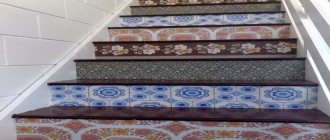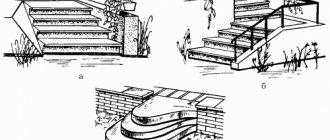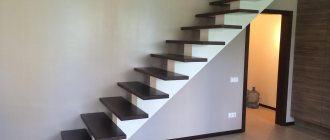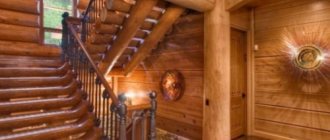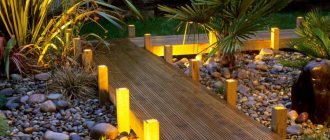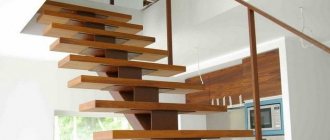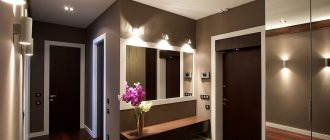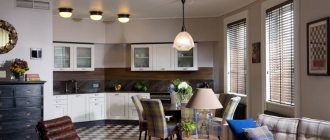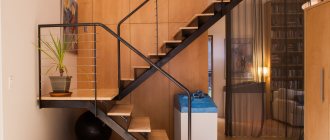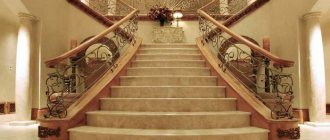In suburban construction, “smart home” technologies are increasingly being used, which implies a convenient and safe organization of living space. Staircase lighting in a house is one of the elements to ensure the safe operation of a home. There are many options for intelligent staircase lighting.
The correct placement of lamps does not distort the contours of the steps and allows you to avoid shaded areas, as a result, a person can climb to or descend from the second floor without risk. The span is illuminated using LED, neon and halogen lamps. The use of specific equipment depends on the material and configuration of the flight of stairs.
Wooden stairs should not be equipped with halogen lamps, as this type of lamp gets very hot during operation, which can lead to a fire.
Lighting fixtures are usually placed along the length of the steps, on the side surfaces, or they are mounted above them in the form of chandeliers or sconces. The color of lighting also plays a significant role, so wooden surfaces are best emphasized by warm, yellowish light, while for metal products a cool, white shade is preferable.
Installation of special lighting for stairwells is mandatory if the following people permanently live in the house:
- elderly people;
- children diagnosed with hyperactivity;
- adults and children with musculoskeletal disorders.
The influence of the design and material of stairs on the choice of lighting
A typical picture: the owner is about to go down an unlit staircase at night, which is quite dangerous for a sleepy person. Since the overhead light switch is most often at the bottom, you have to take a flashlight with you. Even if there is an overhead switch, you won't use it if someone is sleeping in the living room.
The problem can be easily solved by installing staircase lighting on the steps. It is suitable for structures of any size and shape made of concrete, wood, stone, glass. The choice of optimal lighting is influenced not only by the design and efficiency of lighting fixtures, but also by the degree of flammability of the material from which the flight of stairs is made. In private construction, the type of structure is also taken into account, so the following types of lighting organization are common:
- March. The classic, most common form. It is convenient because it allows you to use any type of lighting with any location of light sources.
Lighting of the main staircase Source arch2o.com
- Screw. The spiral design has an impressive appearance and takes up little space, which is why it is often installed in modest-sized housing. To arrange the lighting, use a central support post or wall.
- On pain. The cantilever design looks airy and weightless, but in fact it is not inferior in strength to other forms. Standard methods are suitable for lighting; unusual solutions are often chosen, for example, lighting railings.
The choice of material influences the organization of lighting in its own way; the following lighting design options are considered practical and safe:
- For wooden stairs. The main disadvantage of natural material is flammability, so the wooden frame and steps are treated with fire retardants, which reduce flammability and slow down the combustion process. To organize the lighting, choose lamps with reduced thermal radiation; high-quality insulation of the wiring is also important.
Lighting of a wooden structure Source strojdvor.ru
- For metal (forged). If a decision is made to illuminate the steps, the wiring is insulated in a corrugation. For many interior styles, a suitable solution would be to use wall sconces; The hanging chandelier also looks harmonious.
- From glass. Transparent steps made of impact-resistant glass look unusual; such a staircase will decorate any interior. For illumination, it is enough to install point sources. Diffusing screens will help make the light softer, and it will not dazzle a passing person.
- Made of concrete. The lighting for evening and night hours can be anything: point sources, wall lamps, or a ceiling chandelier are suitable.
An original solution for glass steps Source amazonaws.com
Basic criteria for choosing lighting for stairs
Natural light sources for illuminating the stairs in the house are not always enough to ensure the safety of movement along the steps. Therefore, it is preferable to install lighting on the stairs in the form of LED, neon lamps or other lighting fixtures. Installation is carried out along the width and length of the steps, along the edges and corners, or on the ceiling directly above the stairs. Also often these options are combined with each other.
When choosing the type of lighting, you should consider the following recommendations:
- The devices should not distort the shape and size of the steps in the dark, and also not cast a shadow. Otherwise, the walking person may stumble and fall.
- The first thing to consider is that the lighting area depends on the length of the descent. Thus, the longer the staircase to the second floor is, the more lighting should fall on it.
- Long staircases require a diffused type of lighting. This can best be achieved with spotlights.
- If the staircase is made of wood, the wood must be impregnated with special substances that ensure resistance to high temperatures.
It is also worth considering the overall design. A wooden structure will work best with yellow lighting, while a metal structure will work best with white lighting.
Glass looks harmonious with many shades, so the lighting color is selected based on the overall design. Although such criteria are not mandatory and owners can experiment in this matter.
Methods of lighting stairs
It’s convenient to be able to control the light no matter which way you’re going to move up the stairs. There are several practical ways to organize comfortable management.
Automatic backlight mode
Automatic lighting of the stairs is organized using sensors. To do this, a motion detector is installed that can respond to movement. If a scheme with one sensor is selected, it is installed on the ceiling; providing a complete overview. An option with two sensors is possible, then they are installed at the beginning and end of the march. When a person approaches a flight of stairs, the detector is triggered and lights up.
Automatic LED backlight Source interactive-home.ru
Many options have been developed for organizing the lighting of the stairs to the second floor in a private house with a motion sensor. Depending on the connected system, the settings may change the brightness and speed of ignition and decay of the lamps. You can also configure the turn-off delay (fading animation) of the backlight. Installation for animated lighting is more complex, since wires are laid to each stage.
An alternative to a motion sensor is a load detector, which closes a circuit when the handrail is touched or a load appears on the steps. The sound device is triggered after a sound signal. It is configured for sound (hand clapping) or voice command.
Another option for operating in automatic mode is to use a sensor with a timer. Here the lamps will light up at a given time, for which a program is set, a schedule of turning on in the evening and turning off in the morning is set. It is possible to use the device with photocells, then the operation occurs at a certain illumination of the space.
Combined lighting for a modern interior Source darklightdesign.com
See also: Catalog of companies that specialize in electrical work of any complexity
Wireless backlight
In addition to staircase lighting on steps with a motion sensor, a system based on autonomous energy sources is used. The option is safe and reliable, because it allows you to move up the steps when the electricity goes out. It is especially valuable that when arranging it, you can do without fussing with laying cables and drilling walls. The advantages also include economy, because the light turns on only when needed.
In order to equip a wireless system, they purchase motion sensors of any type, lamps (usually spotlights) and batteries. High-capacity batteries (pinky, AAA) handle the role of the battery.
Installation of luminaires in the horizontal plane of steps Source brilliantlighting.co.uk
Regular (network) model
Anyone who refuses to run around at night with a flashlight should organize the lighting of the staircase steps using walk-through switches. Their design is more complex than that of standard analogues, but it allows you to turn the light on and off from several points. There should not only be two pass-through switches, from the edges of the flight of stairs. You can make another one, for example, at the entrance doors.
To implement network lighting, draw up a wiring diagram and prepare the surfaces where the cable will be laid. If the walls are wooden, plastic cable ducts will be required; grooves are laid in concrete partitions.
LEDs: economical and reliable Source ytimg.com
DIY staircase lighting (instructions)
The lighting of the stairs with LEDs looks quite original and beautiful. Lighting effects guarantee comfortable movement and transform the interior beyond recognition. The equipment is sold as a complete set, so if you have basic knowledge, you can assemble the system yourself.
Regular
For simple lighting from the network, you will need a switch. The side surfaces or overhangs of the steps are equipped with LED strip. The system is started by a button located on the wall. To work, you will need an aluminum profile, metal scissors, a ruler or tape measure, self-tapping screws, a drill and a screwdriver.
To make the appearance of the lighting more attractive and hide the LED strip, also purchase a plastic plinth to hide the electrical wiring.
The process of installing LED backlight from the mains is as follows:
- At each step of the stairs or at the junction between the wall and the steps, you need to install an aluminum profile, which is secured with self-tapping screws.
- The installed profile must be degreased. Alcohol, white spirit or another product is usually used for this purpose.
- The LED strip needs to be cut into segments, the length of which corresponds to the width of the steps; you can make them 5-8 cm smaller.
- The protective film is removed from the tape, the finished elements are glued to the pre-installed profile.
- Next you need to output the contacts for the LEDs. This is done on both sides of the tapes, the outer contacts are connected to a common electrical cable.
- All that remains is to connect the controller and power supply and start the system. To hide the LED strip, you can install a plastic plinth on the profile.
Related article: Optimal dimensions of stairs: designing a safe and comfortable structure
The figure below shows an approximate diagram of connecting LED lighting for a single-flight staircase.
On the video: how and to what to connect the LED strip.
Automatic
The circuit is based on the relationship between the sensor and the controller (preferably use an Arduino/arduino device). Touch sensors are installed directly opposite the lower and upper steps, and when moving, the LED controller is activated.
To assemble an automatic system, you need to purchase the following components:
- controller - the main component of the entire scheme, suitable for most stairs;
- board with circuits required to install the controller;
- LED driver - a microcircuit connected to the controller outputs;
- sensor sensors - they are the ones who will respond to movements;
- a photocell that is installed so that the light does not turn on during the day;
- You will also need wires to connect and connect all components.
Before starting installation with your own hands, you need to assemble the circuit and run it in test mode to make sure that the components are in working form. To do this you need:
- Connect the controller to the computer and download the control code.
- Install the controller on the board, connect it to the LED drivers and connect it to the tape outputs.
- Make two additional pins for the sensors responsible for turning on the light.
In addition to the above components, it is also recommended to install a switch that will allow you to turn off the system or switch to permanent mode.
On video: smart staircase lighting - how it works.
After the system is assembled, installation begins. Do-it-yourself automatic LED lighting of the Arduino staircase is mounted in the following order:
- The required number of fragments are cut from the tapes.
- The ends of the tapes are closed with special connectors.
- After degreasing the steps with acetone, LED strips are glued.
- Opposite the lower and upper steps, holes are made into which socket boxes are installed and touch sensors are recessed.
- The wires from the sensors are routed through grooves under the steps, and a cable duct is attached to the stringer.
- The control module box is placed in an enclosed area, often under a ladder.
- The conductors are connected, after which the cables are connected to the connectors on the board.
After a test check, if no problems or inaccuracies are identified, this system is launched into permanent operation.
On the video: the process of installing and connecting automatic staircase lighting.
Having familiarized yourself with the methods of organizing staircase lighting and understanding what types of lighting fixtures are best used in each individual case, you can safely develop your own scheme. You will also need to make a list of the necessary materials and equipment used.
Review of automatic LED lighting of steps (2 videos)
Functional and decorative lighting (58 photos)
What light sources are most practical?
When choosing staircase lighting in your home, it is important to become familiar with the characteristics of various lamps. Knowing the pros and cons will help you evaluate different options and choose the best one. The following types of sources are allowed:
- Incandescent lamps. Due to their low cost, they still remain popular, despite the high heat and wasteful energy consumption.
- Halogen. They are distinguished by bright, even light and are used in chandeliers or sconces. They are not suitable for local illumination of steps (especially wooden ones) due to their brightness and rather noticeable heating. Halogen lamps are sensitive to voltage surges.
Combining three types of lamps Source pinimg.com
- Neon (gas discharge). The color of the dump depends on what gas is inside. Neon has a red-orange glow color, but in principle it can be anything. Models in the form of tubes are used for longitudinal illumination of steps; the light is soft and does not hurt the eyes. The lamps last a long time, but require delicate handling.
- LED. Popular due to their stable bright glow, low energy consumption, and variety of assortments. They have an impressive service life and are suitable for installation on wooden elements, as they practically do not heat up. Available in different forms: lamp, point source, tape.
Recessed LED luminaires Source diodeled.com
The principle of operation of LED lighting for stairs in a private house
Smart lighting is sensitive to the movements of a person moving along the steps. It turns on and off very smoothly.
By adjusting the lighting operation, you can:
- set the required turn-on speed, and also adjust the time of activated lighting for the cantilever staircase;
- make sure that the backlight turns on on all steps simultaneously when a person approaches the flight of stairs, and also set the mode for turning on individual sections one by one;
- set the “standby” mode for a certain number of steps (for example, in this mode, only the outer steps can be illuminated, so that in the dark a person can figure out which step to start with).
In addition, you can use non-main illumination of the outer steps, with the help of which the staircase will be illuminated in complete darkness. This mode assumes that the light brightness level will be activated only by 10%.
It is possible that you will be interested in information on how to choose siding for your home, which you can read about here.
The device can be placed in an appropriate place convenient for operation. Two motion sensors are usually installed on the outer steps, which react to a moving object. When approaching, they turn on, illuminating the entire staircase. The light also goes off automatically after a certain time after stopping movements, which can also be configured.
This type of lighting can be used for interior and exterior stairs
When installing lighting on a street staircase, it is necessary to take into account changes in temperature conditions, weather changes, and humidity levels. Therefore, it is easier to use automation in the house, since outdoors the chance of equipment breakdown increases.
You may also be interested in material about wooden railings for stairs.
It is more important to use smart lighting for long staircase structures. For long flights, it is appropriate to alternately adjust the light of several steps.
Lighting fixtures: how to choose and where to install
Lighting for a flight of stairs is selected at the design stage of the house, because it is required not only to be functional, but also to match the design of the staircase and the rest of the interior. Manufacturers offer a wide selection of lamps, and almost all are suitable for organizing staircase lighting.
Lighting should be consistent with the overall design Source cloudfront.net
Spotlights
The small size allows these products to be effectively used for organizing any form of lighting. A feature of point models is the creation of a directional light flux.
Depending on the characteristics of the lamps, the light can have different color temperatures, which is used to achieve different visual effects. Cool shades visually expand the space, while warm tones create a feeling of comfort.
Using spotlights Source enzie.com.au
For stairs with illuminated steps, several LED layouts are offered: through one or two steps, in the center or on the sides. Spotlights are used in the following parts of the structure:
- On the wall along the steps. If network lighting is planned, a method for masking the wiring and creating niches for the devices themselves must be thought out in advance. The easiest way to do this is on a plasterboard surface.
- In the risers. Useful lighting will be obtained if you place point elements in the risers (vertical elements). This solution allows you to get rid of distortion of the contours of the steps.
- On the steps. Installation on the horizontal surface of steps is carried out quite rarely. Here they choose less powerful products that do not irritate the eyes at night.
An eye-catching location Source chewjoinery.co.uk
LED strips and neon tubes
Flexible tape is a popular way to break up the darkness in a stairwell. Like all other LED-based products, the strips are economical in energy consumption, do not heat up to dangerous levels and are mounted according to a simplified scheme.
The tape, due to its plasticity, is fixed on a surface of any shape using an adhesive base; sometimes a metal profile is used. Traditional mounting locations: wall along the stairs, edge of steps, under railings.
Neon tubes are also used to create illuminated stairs. They are elastic, last a long time and create a pleasant diffused light that does not strain the eyes at night. Unlike LED strips, neon tubes create circular rather than directional light.
Creative solution to a problem Source pinimg.com
Types of lighting fixtures and their installation location
The lighting of the steps of the staircase and the structure to the second floor as a whole should be functional and organically combined with the design forms of the staircase. Therefore, it is better to choose the lighting option at the planning stage of a private house.
LED strips and tubes
LED strips consist of an aluminum sheet on which the lamps are placed. The devices come in different colors, which will allow you to choose the most optimal solution for the type of staircase or interior.
LED lighting makes it possible to highlight the edge of each step separately. Diffusing light creates a comfortable home environment, filling the room with warmth and coziness.
Neon elements consist of an elastic tube in which a cable is installed. The light can be directed 360 degrees.
Spot lighting for stairs
Spot-type lamps provide proportional and uniform distribution of light in the room. The service life is quite long, but the devices heat up during operation. Therefore, lamps should not be in close contact with other objects. In addition, due to changes in the network, the light bulbs in devices burn out, which leads to additional financial expenses. Big butts are definitely one of those phenomena that absolutely everyone likes. If you are a lover of porn and great asses, then do not hesitate and follow the link.
Related article: How to decorate a staircase in a house: choosing a facing material |+65 photos
Wall sconces
Lighting using wall sconces is considered the most common. There are several types of models:
- near-surface - fixed with the back side to the wall;
- sconces with a bracket-base, which allows you to place lamps at different distances from the wall;
- luminaire built into the wall - a mounting recess of at least 4 cm is required.
Mostly sconces are installed in false walls and plasterboard partitions.
Staircase lighting with chandelier
A non-standard option is to use a wall chandelier for staircases. Mostly this design is observed in hotels or large estates. Large lamps are quite large in length.
The chandelier is appropriate for existing high ceilings and appropriate interior design.
Combined lighting option
Based on the parameters of the staircase, the lighting can be combined. A combination of wall, ceiling and stair lighting looks impressive and fashionable in a modern interior.
It is important to pay attention to the fact that thoughtfully placed built-in or wall lighting elements can visually change the geometry of the space. For example, by directing the lamps upward, you can visually increase the height of the ceiling.
How to choose a backlight: 4 useful criteria
Staircase lighting will be practical and of high quality if the following criteria are taken into account when choosing:
- Backlight level. If the staircase area has access to natural light, you can choose low-wattage lamps and reduce their number.
- Economical. Stairs are used regularly, so smart staircase lighting with sensors that are triggered by movement or sound would not hurt.
- Autonomy. It is useful if there are occasional power outages.
- Brightness of lamps. The lamps are positioned so that the light does not interfere with movement. For long flights of stairs, it is better to provide diffused lighting.
It is important not to overdo it with brightness Source futurecdn.net
Advantages of step lighting
- Safety. Properly designed lighting will make it possible to comfortably and conveniently go up and down the stairs. Good light will prevent various traumatic situations. This is especially true in rooms where there is no natural light or railings are not provided. Light should not distort the true dimensions of the stairs and steps.
- Beauty. Properly selected light sources will help to decorate the interior of the room in an interesting way. Modern design solutions amaze the imagination with their diversity. Well-chosen light will make it possible to expand the space or create interesting and original details.
- Saving. Electricity consumption depends on the type of lighting device chosen.
Briefly about the main thing
Staircase lighting is varied in implementation options; its choice is influenced by the type of staircase structure and the material from which it is made. Lighting can be organized automatically, using motion or sound sensors. A timer will be beneficial, as will an autonomous power supply, making your safety independent of external conditions.
Light on the steps is not only useful, but also beautiful. Neon and halogen sources are used for decoration; incandescent lamps and LED products are more popular. Sconces and spotlights are common lighting fixtures; they are complemented by LED strips and neon tubes. Any surface is suitable for installation: steps, walls, railings. The criteria for choosing the type of lighting are the design and room features, as well as the characteristics of the lamps.
Ratings 0
Types of stairs and suitable lighting for them
There are several types of stairs and each one is suitable for a certain type of lamp. Based on the features of the design itself, it is worth considering many factors that can affect the operation of the lamps.
Screw
In this case, round steps are used. Screw structures have small dimensions. This becomes the reason why the light is installed in the form of a fence. You can use the side wall as a place to mount lamps.
But at the same time, each step of the element must be illuminated. Spiral staircases are considered the most unsafe.
This staircase configuration goes well with LED lamps.
Wooden and metal
Wood has high flammability, so before installing such a staircase at home, it is treated with a specialized agent - a fire retardant. It is also important that the wires have good insulation.
Systems with low current are selected for lighting. Lamps are installed with a minimum amount of heat generated.
Metal is rarely used in the manufacture of stairs. The design is slippery. This causes the installation of additional overlays. Metal is the main conductor of electric current. Therefore, the cable must be insulated by any available method.
For forged structures, lighting is optimal with lamps that are attached to the wall or ceiling.
It is possible to use diodes, but provided that the steps do not have additional ledges. If available, it is best to use spot lighting.
Stairs with transparent steps
The design helps create a feeling of lightness. The main material in the manufacturing process is glass with an increased level of strength.
The design allows us to limit ourselves to spotlights. They are installed at the level of the steps. To achieve additional glow, you can direct the light onto the narrow side of the crossbars.
Concrete stairs
Concrete is used only when you want to get a high-strength structure. After complete hardening, the ladder cannot be disassembled.
You need to think about lighting in advance, since the cables are mounted in a concrete structure.
There is no need to use cheap materials. Otherwise, the entire staircase structure will have to be dismantled in the near future.
It is better to highlight concrete stairs with sconces, and fasten them at a level of half a meter from the steps themselves. It is permissible to use a ceiling lamp if the span height allows this.
You may be interested in: Practical apartment design
Marching
Classic staircase. Movement along it resembles a march. If the house has just such a design, then any type of lighting can be used. Lamps are installed in various places - it’s up to the imagination of the home owner. The LED lighting under each step looks good.
Types of lighting fixtures
Lighting is an important element of staircase decor, which brings with it both aesthetic beauty and ensures safe movement in the dark. Often, lamps in rooms and natural light are not enough to provide the structure with proper lighting. Then it is necessary to install additional lighting for the stairs.
There are several types of lighting devices:
- sconce;
- LED Strip Light;
- spot lighting;
- chandelier in the span;
- combined lighting.
Let's take a closer look at each type of device.
Spot lighting is provided thanks to a variety of lighting fixtures that are located pointwise. She looks very impressive. There are several ways to do it.
- Lighting built into the steps. To install lighting fixtures, holes are made in the steps and wiring is routed out. You can arrange the light bulbs in different ways. You can install them one at a time or every other step; you can install one lamp in the center or two at the edges. The heavy staircase structure becomes visually “lighter” thanks to the glow.
- Lamp. If you don’t want to spoil the cladding of the steps, you can purchase spotlights. Usually they are placed on the side of the step near the wall or under the railing at a point. They are fixed either with a self-adhesive base or with bolts. In some models, you can adjust the direction of the light thanks to the rotating head.
- Lanterns on the railing. Quite an effective lighting option. The lantern is mounted on balusters. Thanks to this installation, the steps, railings and the entire staircase structure as a whole are illuminated. Therefore, for sufficient illumination of the stairs, sometimes one or two lamps are enough.
- Wall lamps. The lamps cut into the wall pointwise along the entire length of the stairs. It looks very stylish and unusual.
A wall sconce is an even simpler lighting option that does not require any special intervention in wall cladding. The lamps are attached to the wall and connected to the power supply. To ensure good illumination, it is enough to install several sconces, as they have great power.
This type of backlight can be turned on mechanically or automatically if a motion sensor is installed. Typically, one switch is installed at the top and bottom to turn all sconces on and off simultaneously.
To install the sconce upon completion of the repair, you should ensure the presence of wire outlets in advance. If you do not take this into account in advance, you can lay wiring along the wall or make recesses. As an alternative to this, you can install lamps that run on external batteries.
A flying chandelier is the most spectacular and expensive way of lighting. The chandelier is ideal for a multi-flight staircase. Typically, such structures are found in public places such as hotels, theaters and in historical places - palaces and large estates.
Externally, this chandelier is distinguished by its massiveness and length. Its task is to completely illuminate the entire staircase opening. It is suspended from the ceiling of the upper floor and goes down along all the flights of stairs. Great for lighting a spiral staircase.
LED strip is a flexible strip with many energy-saving lights. Such devices are distinguished by a variety of colors. They are quite easy to install anywhere. They are attached, as a rule, thanks to their sticky side, if present, or they are placed on glue. Such lamps do not heat up, and therefore they are completely safe.
Two power supplies are attached to the tape, one converts electrical energy for lighting, the other serves to connect to the electrical network. In addition, it is energy saving. The amount of electricity consumed is 12 or 24 Volts. The number of working hours is approximately 50 thousand.
To achieve greater illumination or to be able to choose one or another lighting option depending on the conditions, sometimes combined lighting is installed, combining, for example, spot and wall lighting. This set is an interactive novelty of our time.
Designer lighting
Designers consider using only one type of lighting too boring, so they often create unusual combinations. Thus, classic interiors are simultaneously illuminated by sconces and chandeliers. You can find forged models and the same lamps with beautiful lampshades.
Spot lighting for stairs is rarely used independently. In such an interior there may be sconces in a modern style or ceiling lamps. You can combine LED strip, sconces and floor lamps in one room. There are no restrictions or requirements if everything fits into the overall design concept. The main thing is that the light sources are in the same style, combined with the decoration, stairs and decorative items.
Automatic backlight
Its installation will save you from having to manually turn on the light. To turn the backlight on automatically, you can set:
- Motion Sensor;
- timer;
- sound device;
- load sensor
The first one will be triggered when someone approaches the stairs. The timer can be set for the period of time during which you are at home. But this is not always convenient. If you install a sound sensor, the light will light up when you clap your hands or when talking. The load sensor is triggered when you place your feet on a step or touch the railing.
When choosing a backlight, remember that any automation can malfunction and one day not work. In this case, you should know how to turn off all sensors and where the regular switch is located in the house.
Types of lighting
Recessed lighting for stairs are small lamps that are usually located along the direction of the stairs. They can be wall-mounted, lamps on steps, or floor lamps.
LED strip is very popular because it has low power consumption and is also easy to install.
It is made in the form of a tube, which contains diodes inside, and is available in different colors, which allows it to harmoniously fit into any interior.
A staircase chandelier is installed in spacious rooms; you can match it to the overall design of the room and be sure that it will fit harmoniously into it.
It is suspended from the ceiling, and also connected using a cable, which is safely placed under the external decoration of the walls.
Using sconces to illuminate a room, they will perfectly complement the overall design of the room.
To connect this type of lighting, they resort to a common network or using a cable channel. Depending on the length of the staircase, the total number of lighting fixtures is determined.
To illuminate a small staircase, one is enough; for longer ones, two or more are used. They are all combined into a common circuit and output to a common switch. If necessary, you can install a motion sensor.

